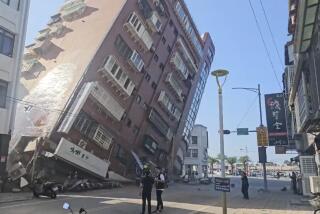Earthquake in Remote Area of Western China Kills 55
- Share via
PEKING — An earthquake near the Chinese-Soviet border killed 55 people in Wuqia, western China, flattened 85% of the houses in the town and severed communications, the state seismological bureau said today.
The quake measured 7.4 on the Richter scale, said a bureau spokesman who identified herself only as Mrs. Gao. It struck at 8:41 p.m. Friday in Wuqia, a farming area in China’s vast Xinjiang Uighur autonomous region.
In Washington, Don Kelly, a spokesman for the U.S. Geological Survey, said this was the strongest earthquake anywhere in the world since the 7.8 magnitude quake that took at least 177 lives in Chile on March 3.
The jolt claimed 19 lives in Wuqia county and 36 on Wupar commune in neighboring Shufu county, said Zhu Lingren, deputy director of the Xinjiang Seismological Bureau in the regional capital of Urumqi.
“Eighty-Five percent of the houses in the county seat of Wuqia were flattened. But the quake area is sparsely populated and mainly pastoral,” said Zhu, reached by telephone from Peking.
“There’s no figure on the injured, he added. “People have moved out of their houses and are now living in the open.”
Soldiers were dispatched to help with rescue work, Zhu said.
The jolt was also strongly felt in Kashgar and the nearby town of Shule, Mrs. Gao said.
Houses Collapse
She said most of the wooden houses in Wuqia collapsed.
“There was other damage, but communications with the city are difficult due to the earthquake, and we can’t get all the details now,” she said.
The region has been the site of several major earthquakes.
Wuqia is a mountainous county seat near the edge of the desert-like Tarim Basin, where China’s Tianshan Mountains meet the Pamirs Plateau stretching into the Soviet Union near the borders with Pakistan and Afghanistan.
Wuqia is about 80 miles northwest of Kashgar, the population center in the area with 300,000 people. Kashgar was an important stop on the ancient Silk Road through central Asia by which European traders reached China.
On April 5, 1983, a quake estimated at magnitude 5.6--capable of causing considerable to severe damage--rocked the same area as Friday’s temblor. A few injuries were reported in China.
China’s worst previous modern earthquake was in the northeast industrial city of Tangshan on July 28, 1976, when a jolt measuring 7.8 on the Richter scale razed the city and claimed an official death toll of 242,000 people. Unofficial estimates placed the figure much higher.
The small Soviet republic of Kirghizia lies across the border from China, about 100 miles west of the epicenter of Friday’s earthquake.
The official Soviet news agency Tass reported the earthquake Friday and said the its epicenter was in the Central Asian republic of Kirghizia along the border with China.
Tass said the quake was felt in several large cities in Soviet Central Asia.
Kelly, the U.S. Geological Survey spokesman, said that an earthquake measuring seven on the Richter scale is capable of causing widespread, heavy damage. An earthquake of magnitude eight is considered a “great” earthquake, capable of tremendous damage.
Measures Ground Motion
The Richter scale is a measure of ground motion as recorded on seismographs. Every increase of one number means a tenfold increase in magnitude. A reading of 7.5 reflects an earthquake 10 times stronger than one of 6.5.
A team of U.S. earthquake specialists was in China at the time of the latest quake, but they were in the eastern part of the country and could not be contacted immediately, Kelly said.
More to Read
Sign up for Essential California
The most important California stories and recommendations in your inbox every morning.
You may occasionally receive promotional content from the Los Angeles Times.













